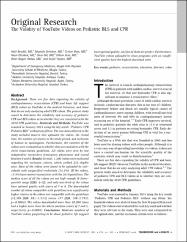The Validity of YouTube Videos on Pediatric BLS and CPR

View/
Date
2016Author
Beydilli, HalilSerinken, Mustafa
Eken, Cenker
Eliçabuk, Hayri
Dal, Onur
Acar, Ethem
Yaylacı, Serpil
Metadata
Show full item recordAbstract
Background: There are few data regarding the validity of cardiopulmonary resuscitation (CPR) and basic life support (BLS) videos on YouTube in the medical literature, and those that do are only analyzing adult CPR videos. The present study aimed to determine the reliability and accuracy of pediatric CPR and BLS videos as to whether they are consistent with the 2010 CPR guidelines. Materials and Methods: YouTube was scanned in January 2015 using the key words "Pediatric CPR Pediatric BLS'' without any filters. The raw data collected in the study included sources that uploaded the videos, the record time, the number of viewers in the study period, and inclusion of human or mannequins. Furthermore, the contents of the videos were evaluated as to whether they are consistent with the 2010 resuscitation guidelines. All videos were seen by two independent researchers (emergency physicians) and scored between 0 and 8. Results: In total, 1,200 videos were evaluated regarding the exclusion criteria, which yielded 232 eligible ones. Most of the videos were found to be uploaded by individuals with unspecified credentials (34.1%). Of the videos, 15.5% have content inconsistent with the 2010 guidelines. The median score of all the videos are not high enough (5 [interquartile range (IQR), 4-7]), and only one-third of the videos have optimal quality with scores of 7 or 8. The downloaded number of videos compatible with guidelines was significantly higher relative to the videos not compatible with the guidelines (15,38([IQR, 881-31515] versus 477 [IQR, 108-3,797); p = 0.0001). The videos downloaded more than 10,000 times had a higher score than the others (median scores of 7 and 5, respectively; p = 0.0001). Conclusions: Moderate numbers of YouTube videos purporting to be about pediatric life support have optimal quality, and few of them are perfect. Furthermore, YouTube videos uploaded by news programs with an insufficient quality have the highest download rates.

















